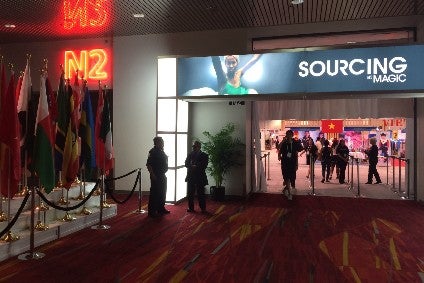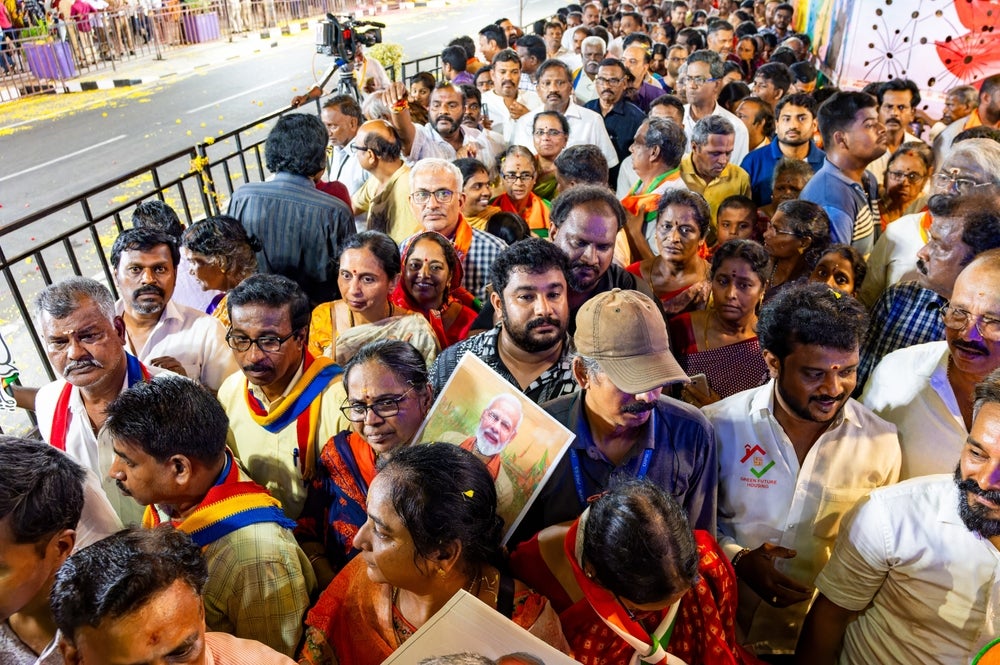
The MAGIC trade show held earlier this month in Las Vegas provided Dr Sheng Lu, associate professor in the Department of Fashion and Apparel Studies at the University of Delaware, with an ideal opportunity to talk with vendors from some leading apparel sourcing destinations about the latest sourcing trends and the overall business environment.
MAGIC is the largest fashion trade show in North America and, as usual, the latest event was crowded and fast-paced. It attracted thousands of attendees, including vendors, buyers, service providers and educational institutions coming from over 40 countries and regions.
China
Despite escalating trade tensions with the US, the Chinese delegation continues to have the largest presence at the MAGIC, reflecting the country’s unshakable and dominant role as the top textile and apparel supplier. As estimated, Chinese vendors accounted for over half of the booths at the Sourcing at MAGIC show, covering all major product categories from menswear, womenswear, intimates, children’s wear and home textiles to fashion accessories. No other country can compete with China for such a complete product offer and production capacity.
Understandably, the US Section 301 tariff action against China is a big concern to Chinese textile and apparel vendors. Even though apparel is not directly targeted yet, companies say the uncertainty is hurting their business. However, several Chinese factory owners expressed more optimism than I had expected. According to them, the additional tariff would NOT change the fundamentals of the business, because apparel sourcing today is more than just about price – it is also about speed-to-market, quality, capacity, compliance risk and flexibility.
How well do you really know your competitors?
Access the most comprehensive Company Profiles on the market, powered by GlobalData. Save hours of research. Gain competitive edge.

Thank you!
Your download email will arrive shortly
Not ready to buy yet? Download a free sample
We are confident about the unique quality of our Company Profiles. However, we want you to make the most beneficial decision for your business, so we offer a free sample that you can download by submitting the below form
By GlobalDataSee Also:
In response to the challenging market environment, Chinese vendors say they will focus on product innovation and value creation to sustain their businesses. Many are also confident that their decade-long ties with US clients will pay off. In particular, most of China’s competitors in Asia – such as Vietnam, Bangladesh and Cambodia – still rely heavily on imported fabrics from China, meaning that apparel ‘Made in China’ remains price competitive, especially for high-end orders in relatively small quantities.
On the other hand, some Chinese apparel companies plan to accelerate their “going out” strategy – that is, moving factories overseas. Statistics from China’s Ministry of Commerce (MOFCOM) show that over 55% of foreign direct investment (FDI) made by Chinese textile and apparel companies in 2017 went to Southeast Asia, particularly countries like Myanmar, Vietnam and Cambodia. It is also common practice for Chinese companies to invest in developed countries and regions such as the US and the European Union to strengthen their research and development (R&D), design and product innovation capability.
Vietnam
Vietnam continues to be a rising star at MAGIC. Apparel exporters from Vietnam say they received more sourcing orders in the past year and expect such momentum to continue in 2018. Official trade statistics echo the trend: in value terms, 14.4% of US apparel imports in 2017 came from Vietnam, up from 13.4% a year ago. In the first half of 2018, Vietnam’s market share reached 15.0% – a new record high.
While Vietnam’s apparel exports keep growing, its factories are increasingly stressed about fulfilling additional orders due to a shortage of workers, production techniques, and raw material. Notably, over 70% of fabrics needed by Vietnam still have to be imported. Compared with China, which can produce almost anything in any quantity, apparel factories in Vietnam are much more limited in what they can handle. However, it is almost a consensus view that once the EU-Vietnam Free Trade Agreement (EVFTA) takes effect later this year or next, apparel factories will have more leverage in price negotiation with US and EU importers.
Bangladesh
Overall, vendors from Bangladesh are optimistic about their business outlook in 2018 because US fashion brands and apparel retailers are keen to diversify their sourcing bases. According to the 2018 US Fashion Industry Benchmarking Study released in July by the US Fashion Industry Association (USFIA), nearly half of surveyed respondents expect to somewhat increase sourcing from Bangladesh through 2020, up from 32% in 2017. Data from the US Department of Commerce also shows that in value terms, 7.1% of US apparel imports came from Bangladesh in the first half of 2018, a notable increase from 6.3% in 2017.
Of concern to vendors from Bangladesh, however, is the fact the country is still regarded as a place with a high risk of non-compliance following the Rana Plaza tragedy in 2013. To reassure clients that it is safe to source from Bangladesh, many vendors chose MAGIC to highlight their collaboration with third-party certification programmes such as Worldwide Responsible Accredited Production (WRAP).
Vendors also expressed mixed feelings about the Accord on Fire and Building Safety in Bangladesh (Accord) and the Alliance for Bangladesh Worker Safety (Alliance) leaving the country after this year. While many in Bangladesh would like to be treated as a “normal country” for apparel sourcing, the presence of the Accord and the Alliance offers assurance to US importers about Bangladesh’s credibility on social compliance.
Central America
Vendors and industry associations from Central America are excited that the region is growing in popularity as an important sourcing base for US fashion brands and apparel retailers. The China factor and uncertainties around the renegotiation of the North American Free Trade Agreement (NAFTA) have helped US apparel imports from Central American enjoy robust growth in the first half of 2018, particularly Guatemala (up 3.3%) and Nicaragua (up 4.1%). Nevertheless, to expand production in Central America further, vendors say that capacity building support is critical, especially workforce training.
Meanwhile, the Central America Free Trade Agreement (DR-CAFTA) plays an indispensable role in supporting the region’s apparel exports to the United States – its single largest export market. Interestingly, when asked about the use of DR-CAFTA for exports, vendors say the trade agreement’s short supply list mechanism is significant, because woven apparel made in Central American countries often has to use imported fabrics from Asia.
In other words, without this provision, it would be extremely difficult for Central American countries to export some major categories of apparel to the United States duty-free because they are unable to comply with the strict yarn-forward rules of origin required by the agreement.
Sub-Saharan Africa
Sub-Saharan Africa (SSA) countries, particularly members of the African Growth and Opportunity Act (AGOA), are widely regarded as the emerging sourcing base for US fashion companies. It is encouraging that over the years vendors from a growing number of SSA countries are showcasing their products at the MAGIC, including Ethiopia, Mauritius, Nigeria, South Africa and Rwanda,
During my conversations with several SSA vendors, three themes were mentioned repeatedly:
First, garment factories in SSA countries appreciate their governments’ support and genuine interest in developing the local textile and apparel industry as a tool for economic growth, job creation, and industrialisation.
Second, AGOA means so much to SSA countries serving as an apparel sourcing base. Notably, AGOA offers two unique competitive advantages when competing with suppliers from Asia and the western hemisphere:
- Duty-free market access to the United States;
- Liberal rules of origin. In particular, AGOA’s “third-country” fabric provision allows eligible countries to export apparel to the US duty-free by using yarns and fabrics sourced from anywhere in the world. In comparison, most US free trade agreements adopt strict yarn-forward rules of origin, which, in general, require that all yarn spinning, fabric weaving, and apparel cut and sew happen within the FTA region.
Third, vendors from SSA countries understand that it is urgent for them to build up genuine export competitiveness beyond AGOA itself, which is set to expire in 2025. However, to achieve this goal, receiving external investment and capacity building support is essential. Despite the relatively low wage level, the overall production cost remains high in most SSA countries due to their poor infrastructure and low productivity.
However, few US fashion companies are interested in building textile and apparel factories in the SSA region, and most foreign direct investments are made by Chinese, South Korean and Taiwanese investors. Nevertheless, the promise of sourcing orders from US and EU brands provides important financial incentives for these Asian investors to continue their investments in the SSA textile and apparel industry.
Made in USA
Last but not least, the ‘Made in USA’ area attracted a lot of traffic at this edition of MAGIC. However, compared with a few years ago, technology companies, rather than conventional apparel manufacturers, were more visible. These vendors displayed a wide variety of products ranging from 3D design software, digital printing solutions, to inventory management systems. Meanwhile, Industry 4.0, artificial intelligence, automation in garment manufacturing and digitalisation in the fashion industry have become popular conversation topics.
The increasing application of these digitalisation and automation technologies in the fashion industry is also seen as an opportunity for reshoring or onshoring. However, even with their help there is no obvious business model that can support a sizable return of ‘Made in USA’ apparel, let alone those lost labour-intensive sewing jobs. How to rejuvenate ‘Made in USA’ will be an ongoing discussion, but for sure, the future will be a much different world.
See also: Trade policy remains top sourcing concern for US fashion firms









Related Company Profiles
Magic Srl
Ministry of Commerce, Thailand
Worldwide Responsible Accredited Production
Sub-Saharan Africa
SSA KK